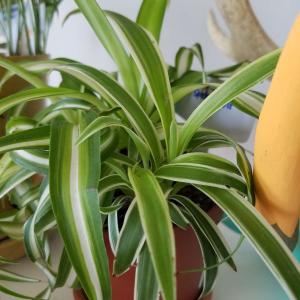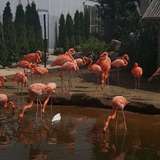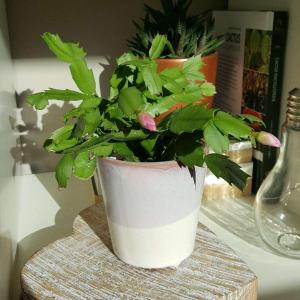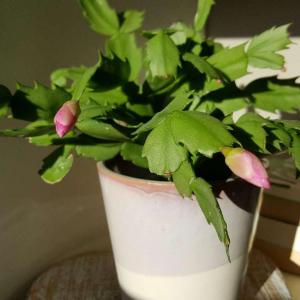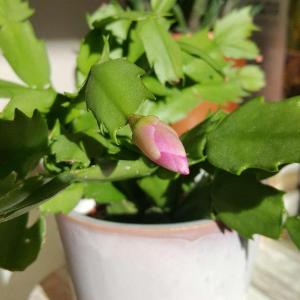成长记
Llamadrama
2017年11月11日
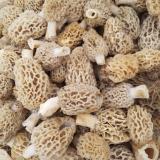
I now added "Crassula Ovata - Jade Plant 'E.T.'s Fingers'" in my "garden"


0
0
求助
Febrian Djaka Putra
2017年11月11日

Anyone know what name of this plant?


0
0
Ueca:This is either a variegated Crassula coccinea or Crassula capitella (which appears to be somewhat less common).
成长记
astronbot
2017年11月10日

First time watering!! I should've noticed the shriveling leaves eariler.. but this is my densest plant so it was hard to see!!
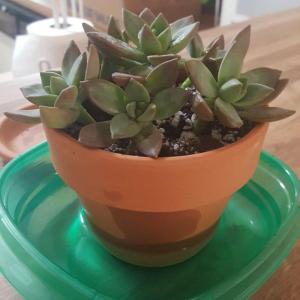

0
0
Naisk:Don't worry, the leaves will come back to normal in few hours/days after watering ;)
文章
Miss Chen
2017年11月10日

Strawberries, unlike many other fruits, grow on plants close along the ground, and put out their own runners for propagation. In Arkansas, strawberry plantings are split into two seasons.

Fall Planting
Many commercial growers plant their strawberries in the fall, to allow the plants to take root and establish over the winter for early spring blooming. When planting in fall, it's important to cover the strawberries with organic or plastic mulch to protect them through the winter.
Spring Planting
Most home gardeners choose to plant strawberries in the spring instead, for a more natural growing season. Spring plantings in Arkansas take place mid-April, when the ground has thawed to 55 to 60 degrees Fahrenheit, and is welcoming to young strawberry plants.

Location and Planting
Strawberries require plots that receive full sunshine all day, every day, to take advantage of the lush Arkansas warmth. The plants cannot tolerate crowding or wet feet, so in swampy areas of Arkansas, it's important to raise the beds or mix natural soil with plenty of quick-draining soil and compost.

Fall Planting
Many commercial growers plant their strawberries in the fall, to allow the plants to take root and establish over the winter for early spring blooming. When planting in fall, it's important to cover the strawberries with organic or plastic mulch to protect them through the winter.
Spring Planting
Most home gardeners choose to plant strawberries in the spring instead, for a more natural growing season. Spring plantings in Arkansas take place mid-April, when the ground has thawed to 55 to 60 degrees Fahrenheit, and is welcoming to young strawberry plants.

Location and Planting
Strawberries require plots that receive full sunshine all day, every day, to take advantage of the lush Arkansas warmth. The plants cannot tolerate crowding or wet feet, so in swampy areas of Arkansas, it's important to raise the beds or mix natural soil with plenty of quick-draining soil and compost.
0
0
文章
Miss Chen
2017年11月10日

Pests are attracted to garden strawberries (Fragaria x ananassa) as much as people are, but companion plants help keep pests at bay. Strawberries grow as perennials in U.S. Department of Agriculture plant hardiness zones 5 through 8 and as annuals in warmer zones. Companion plants for strawberries deter and distract pests, and host beneficial insects, but they don't compete with strawberries for light or nutrients. Space strawberries and their companions according to their final growth dimensions.

Herb Choices
Strawberries thrive in gardens with annual and perennial herb companions. Borage (Borago officinalis) helps strawberries resist insects and diseases, and common thyme (Thymus vulgaris) deters worms, according to a Michigan State University Extension in Kalamazoo County article. Borage is an annual herb that grows 12 to 36 inches tall and 9 to 18 inches wide; it bears bright-blue, star-shaped flowers in summer. Common thyme, which is hardy in USDA zones 5 through 9, grows 6 to 12 inches tall and wide, and bears tiny, lilac flowers from late spring through early summer. Another herb companion for strawberries is oregano (Origanum vulgare). Hardy in USDA zones 4 through 9, oregano varieties range from low, spreading mats to upright, bushes. They bear pink, purple or white flowers.
Vegetable Selections
In the vegetable patch, strawberries' companion plants include onion (Allium cepa), lettuce (Lactuca sativa) and spinach (Spinacia oleracea). Growing 12 to 18 inches tall and 6 to 12 inches wide, onion is grown for its flavorful, aromatic bulbs and leaves; it is harvested as an annual crop. Lettuce and spinach grow 6 to 12 inches tall and wide; they are annual plants. Lettuce varieties include romaine, iceberg, loose leaf and butterhead. A cool-weather vegetable, spinach is an upright plant with leaves rich in iron, phosphorus and vitamins A, B and C. Grow strawberries and vegetable companion plants in alternate rows for their maximum benefit.

Annual Flowering Varieties
Annual flowering plants attract beneficial insects to strawberries they are near. Nasturtium (Tropaeolum spp.) grows 1 to 10 feet tall and 1 to 3 feet wide, depending on the species and cultivar, and bears cream, yellow, orange or red flowers with a spicy fragrance in spring through fall. Marigold (Calendula officinalis), growing 1 to 2 feet tall and wide, bears chrysanthemum-resembling, deep-orange to yellow, early summer flowers that bloom through fall in cool climates. Both of these annuals grow readily from seeds sown directly in the ground just before the average final frost date, and they reseed in favorable conditions.
Perennial Flowering Options
Strawberries are productive ground-cover plants in garden borders with perennial companions. Pincushion flower "Butterfly Blue" (Scabiosa "Butterfly Blue") and speedwell "Foxy Lady" (Veronica "Foxy Lady") thrive in the same full-sun sites and moist, well-drained soil in which strawberries do well. Hardy in USDA zones 5 through 9, "Butterfly Blue" grows 12 to 18 inches tall and wide. It bears 2-inch, lavender-blue, pincushionlike flowers spring through fall and into winter in mild climates. "Foxy Lady," which is hardy in USDA zones 4 through 8, grows 12 to 18 inches tall and 9 to 12 inches wide. It produces 12- to 15-inch spikes of fuschia-pink and white flowers in summer.

Herb Choices
Strawberries thrive in gardens with annual and perennial herb companions. Borage (Borago officinalis) helps strawberries resist insects and diseases, and common thyme (Thymus vulgaris) deters worms, according to a Michigan State University Extension in Kalamazoo County article. Borage is an annual herb that grows 12 to 36 inches tall and 9 to 18 inches wide; it bears bright-blue, star-shaped flowers in summer. Common thyme, which is hardy in USDA zones 5 through 9, grows 6 to 12 inches tall and wide, and bears tiny, lilac flowers from late spring through early summer. Another herb companion for strawberries is oregano (Origanum vulgare). Hardy in USDA zones 4 through 9, oregano varieties range from low, spreading mats to upright, bushes. They bear pink, purple or white flowers.
Vegetable Selections
In the vegetable patch, strawberries' companion plants include onion (Allium cepa), lettuce (Lactuca sativa) and spinach (Spinacia oleracea). Growing 12 to 18 inches tall and 6 to 12 inches wide, onion is grown for its flavorful, aromatic bulbs and leaves; it is harvested as an annual crop. Lettuce and spinach grow 6 to 12 inches tall and wide; they are annual plants. Lettuce varieties include romaine, iceberg, loose leaf and butterhead. A cool-weather vegetable, spinach is an upright plant with leaves rich in iron, phosphorus and vitamins A, B and C. Grow strawberries and vegetable companion plants in alternate rows for their maximum benefit.

Annual Flowering Varieties
Annual flowering plants attract beneficial insects to strawberries they are near. Nasturtium (Tropaeolum spp.) grows 1 to 10 feet tall and 1 to 3 feet wide, depending on the species and cultivar, and bears cream, yellow, orange or red flowers with a spicy fragrance in spring through fall. Marigold (Calendula officinalis), growing 1 to 2 feet tall and wide, bears chrysanthemum-resembling, deep-orange to yellow, early summer flowers that bloom through fall in cool climates. Both of these annuals grow readily from seeds sown directly in the ground just before the average final frost date, and they reseed in favorable conditions.
Perennial Flowering Options
Strawberries are productive ground-cover plants in garden borders with perennial companions. Pincushion flower "Butterfly Blue" (Scabiosa "Butterfly Blue") and speedwell "Foxy Lady" (Veronica "Foxy Lady") thrive in the same full-sun sites and moist, well-drained soil in which strawberries do well. Hardy in USDA zones 5 through 9, "Butterfly Blue" grows 12 to 18 inches tall and wide. It bears 2-inch, lavender-blue, pincushionlike flowers spring through fall and into winter in mild climates. "Foxy Lady," which is hardy in USDA zones 4 through 8, grows 12 to 18 inches tall and 9 to 12 inches wide. It produces 12- to 15-inch spikes of fuschia-pink and white flowers in summer.
0
0
文章
Miss Chen
2017年11月10日

Strawberries can survive in any region throughout North Carolina. The plants thrive in full sunlight; do not plant strawberries in a low-lying area prone to a spring frost.

Time Frame
Strawberries require different planting times for specific regions of North Carolina. Plant strawberry plants during March in the eastern part of the state; in the western part of the state and in the mountains, plant them in late March to April.
Harvest
In eastern North Carolina, strawberries are ready for harvest starting in April. If you plant in the western part of the state, anticipate growth in early May, while mountain strawberries are ready for harvest at the end of May. Pick strawberries in the morning, while they are still cool.

Soil
Test the soil four to six months before planting. Strawberries will thrive in a soil with a pH of between 5.5 and 6.5. If the pH balance is low, raise it by treating the soil with dolomitic lime.

Time Frame
Strawberries require different planting times for specific regions of North Carolina. Plant strawberry plants during March in the eastern part of the state; in the western part of the state and in the mountains, plant them in late March to April.
Harvest
In eastern North Carolina, strawberries are ready for harvest starting in April. If you plant in the western part of the state, anticipate growth in early May, while mountain strawberries are ready for harvest at the end of May. Pick strawberries in the morning, while they are still cool.

Soil
Test the soil four to six months before planting. Strawberries will thrive in a soil with a pH of between 5.5 and 6.5. If the pH balance is low, raise it by treating the soil with dolomitic lime.
0
0
文章
Miss Chen
2017年11月10日

Adventurous Arizona gardeners don't let the state's challenging conditions keep plump, juicy strawberries (Fragaria spp.), hardy from U.S. Department of Agriculture plant hardiness zones 3 through 10, from their planting lists. The diverse climate and soils simply mean that strawberries need some extra TLC. Growing zones in the state stretch from USDA zones 4b through 10, with average winter lows ranging from minus 25 degrees Fahrenheit to 40 F. Whatever your region, proper planting gets Arizona strawberries started right.

Site Selection
Even in Arizona's low desert, unexpected frosts can damage tender strawberry blossoms and steal spring crops. The earliest flowers produce the largest berries, so protection is important.
Plant strawberries on elevated slopes, where cold air drains away and lessens chances of frost damage. Cooler, north-facing slopes generally prompt later blooms, which gives an added buffer against bloom loss.
Strawberries fruit best in full sun locations, but low-desert berries need protection from intense sun. Locations near homes provide frost protection, but avoid west-facing walls that reflect Arizona heat.
Soil Adjustments
Strawberries prefer well-drained, low-saline, organic soil with neutral to slightly acidic pH near 6.5. Most Arizona soils are alkaline and saline, with little organic matter. Without adjustments, strawberries suffer nutrient deficiencies.

Test your soil, and follow test recommendations explicitly. Most Arizona gardens need pH lowered for strawberries, but some have acidic soil. Because Arizona soils contain calcium carbonate, common pH-lowering products, including sulfur, don't often work. Using the wrong amendments or the wrong amounts can leave soil toxic. Don't guess; test.
Layer 2 to 3 inches of organic compost over the planting bed, along with 1 pound of 12-24-12 fertilizer per 100 square feet. Wear protective clothing, including gloves and goggles, and mix the layers in 8 inches deep. Avoid manure-base compost, which may add salts.
Planting Time
Plant Arizona strawberries in late winter or spring, after the last average frost date for your region passes. In Arizona's low desert, this happens in February. Mountain regions wait until June.
Trim roots to about 6-inch lengths, and keep them moist at all times. Use sharp garden scissors or pruners, and sterilize the blades with household disinfectant before and after you trim.
Planting depth is critical. Bury roots, but keep the plant's crown exposed at the soil's surface. Planted too low, strawberries rot. Planted too high, crowns dry out. Space strawberry plants at 12- to 18-inch intervals, and water them thoroughly.
Initial Care
Remove all flowers the first season, so strawberries focus on roots, not fruits. When new growth begins, broadcast 1/2 pound of 21-0-0 ammonium sulfate per 100 square feet. Wear protective clothing, and scratch the fertilizer in lightly; leave roots undisturbed. Water thoroughly, washing any fertilizer from leaves.
Drip irrigation suits Arizona strawberries. Overhead watering promotes disease, fuels weed growth and wastes water to evaporation. A layer of organic mulch, such as pine needles or straw, helps retain soil moisture, inhibit weeds and keep soil cool.
Strawberry roots generally stay in the soil's top 6 inches. The shallow roots need consistent moisture of at least 1 inch per week. Water every three to five days, with up to 2 inches of weekly water during hot weather.
Berry Selection
With Arizona's diversity, match berry types to elevation. Strawberries fall in three main groups: June-bearing, everbearing and day-neutral.
Runner-producing June-bearing strawberries flower and fruit early. If frost nips them, your crop is lost. They suit lower, warmer elevations with few late frosts. Cold-hardy, Minnesota-developed "Mesabi" June-bearing strawberry (Fragaria x ananassa "Mesabi," USDA zones 3 through 8) does well in high-pH Southwest soil.
Multicrowned everbearing strawberries have few runners, but produce smaller crops in spring and fall. Autumn harvest still follows if spring frost hits, but everbearers struggle in low-desert heat. Higher, cooler elevations suit them best, but offer shorter growing seasons. Vigorous "Ogalla" everbearing strawberry (Fragaria x ananassa "Ogallala," USDA zones 3 through 9) withstands arid conditions well.
Day-neutral strawberries flower and fruit all growing season, with fewer runners and smaller berries. Their flowers fail once temperatures go above 70 F. They do best in Arizona's foothills and moderate elevations. Disease-resistant "Tribute" day-neutral strawberry (Fragaria x ananassa "Tribute") tolerates alkaline soil and does well in short growing seasons.

Site Selection
Even in Arizona's low desert, unexpected frosts can damage tender strawberry blossoms and steal spring crops. The earliest flowers produce the largest berries, so protection is important.
Plant strawberries on elevated slopes, where cold air drains away and lessens chances of frost damage. Cooler, north-facing slopes generally prompt later blooms, which gives an added buffer against bloom loss.
Strawberries fruit best in full sun locations, but low-desert berries need protection from intense sun. Locations near homes provide frost protection, but avoid west-facing walls that reflect Arizona heat.
Soil Adjustments
Strawberries prefer well-drained, low-saline, organic soil with neutral to slightly acidic pH near 6.5. Most Arizona soils are alkaline and saline, with little organic matter. Without adjustments, strawberries suffer nutrient deficiencies.

Test your soil, and follow test recommendations explicitly. Most Arizona gardens need pH lowered for strawberries, but some have acidic soil. Because Arizona soils contain calcium carbonate, common pH-lowering products, including sulfur, don't often work. Using the wrong amendments or the wrong amounts can leave soil toxic. Don't guess; test.
Layer 2 to 3 inches of organic compost over the planting bed, along with 1 pound of 12-24-12 fertilizer per 100 square feet. Wear protective clothing, including gloves and goggles, and mix the layers in 8 inches deep. Avoid manure-base compost, which may add salts.
Planting Time
Plant Arizona strawberries in late winter or spring, after the last average frost date for your region passes. In Arizona's low desert, this happens in February. Mountain regions wait until June.
Trim roots to about 6-inch lengths, and keep them moist at all times. Use sharp garden scissors or pruners, and sterilize the blades with household disinfectant before and after you trim.
Planting depth is critical. Bury roots, but keep the plant's crown exposed at the soil's surface. Planted too low, strawberries rot. Planted too high, crowns dry out. Space strawberry plants at 12- to 18-inch intervals, and water them thoroughly.
Initial Care
Remove all flowers the first season, so strawberries focus on roots, not fruits. When new growth begins, broadcast 1/2 pound of 21-0-0 ammonium sulfate per 100 square feet. Wear protective clothing, and scratch the fertilizer in lightly; leave roots undisturbed. Water thoroughly, washing any fertilizer from leaves.
Drip irrigation suits Arizona strawberries. Overhead watering promotes disease, fuels weed growth and wastes water to evaporation. A layer of organic mulch, such as pine needles or straw, helps retain soil moisture, inhibit weeds and keep soil cool.
Strawberry roots generally stay in the soil's top 6 inches. The shallow roots need consistent moisture of at least 1 inch per week. Water every three to five days, with up to 2 inches of weekly water during hot weather.
Berry Selection
With Arizona's diversity, match berry types to elevation. Strawberries fall in three main groups: June-bearing, everbearing and day-neutral.
Runner-producing June-bearing strawberries flower and fruit early. If frost nips them, your crop is lost. They suit lower, warmer elevations with few late frosts. Cold-hardy, Minnesota-developed "Mesabi" June-bearing strawberry (Fragaria x ananassa "Mesabi," USDA zones 3 through 8) does well in high-pH Southwest soil.
Multicrowned everbearing strawberries have few runners, but produce smaller crops in spring and fall. Autumn harvest still follows if spring frost hits, but everbearers struggle in low-desert heat. Higher, cooler elevations suit them best, but offer shorter growing seasons. Vigorous "Ogalla" everbearing strawberry (Fragaria x ananassa "Ogallala," USDA zones 3 through 9) withstands arid conditions well.
Day-neutral strawberries flower and fruit all growing season, with fewer runners and smaller berries. Their flowers fail once temperatures go above 70 F. They do best in Arizona's foothills and moderate elevations. Disease-resistant "Tribute" day-neutral strawberry (Fragaria x ananassa "Tribute") tolerates alkaline soil and does well in short growing seasons.
0
0
成长记
Jayebirdie
2017年11月09日

I now added "Graptoveria Titubans (Porcelain Plant) [may be acaulis?]" in my "garden"


0
0
文章
Miss Chen
2017年11月09日

Tomatoes require a deep root system to help pull water from the soil and keep full plants structurally sound. Helping the plant create a deep root system starts at planting. Deep root growth is increased in tomatoes when the seedlings are set deep in the soil, given plenty of water and given adequate space between plants. Tomatoes with deep root growth are more likely to also have an increase in fruit production over shallow-rooted plants.

Deep-Growth Benefits
Roots that grow deep below the plant help support the above-ground stem and branches. Deep roots are also able to maximize water absorption. Plants with shallow roots have an increased risk of drying out, developing fruit that forms poorly and developing stems that can't support heavy fruit production.
Planting Depth
Planting tomato seedlings deep into the garden soil increases the depth of root growth. The ideal depth for root growth on an mature plant is at least 18 inches, even though the main portion of the root system is found in the first 12 inches. To obtain this depth of root growth, dig a planting hole that allows you to set the seedling so the first set of true leaves are just above the soil line. Additional roots will form off the portion of stem that is below the soil level for a sturdy and deep-set plant.
Soil Factors
Loose garden soil assists in root growth by providing less resistance. Work the soil with a tiller or spade to a depth of 18 inches before planting the seedlings. Soil with a high clay content should be amended with compost to increase the organic content. High clay soils pack easily and are not ideal for deep root growth.

Care Considerations
Deep root growth requires some work on your part. Water tomato plants regularly to keep the soil evenly moist throughout the growing season. Healthy plants will not only grow tall, but also deep into the soil. Tomato plants that are in the fruit-producing stage require more water, up to 1 gallon per day. It is also ideal to set the plants 18 to 24 inches apart so they have adequate room for healthy and deep root growth.

Deep-Growth Benefits
Roots that grow deep below the plant help support the above-ground stem and branches. Deep roots are also able to maximize water absorption. Plants with shallow roots have an increased risk of drying out, developing fruit that forms poorly and developing stems that can't support heavy fruit production.
Planting Depth
Planting tomato seedlings deep into the garden soil increases the depth of root growth. The ideal depth for root growth on an mature plant is at least 18 inches, even though the main portion of the root system is found in the first 12 inches. To obtain this depth of root growth, dig a planting hole that allows you to set the seedling so the first set of true leaves are just above the soil line. Additional roots will form off the portion of stem that is below the soil level for a sturdy and deep-set plant.
Soil Factors
Loose garden soil assists in root growth by providing less resistance. Work the soil with a tiller or spade to a depth of 18 inches before planting the seedlings. Soil with a high clay content should be amended with compost to increase the organic content. High clay soils pack easily and are not ideal for deep root growth.

Care Considerations
Deep root growth requires some work on your part. Water tomato plants regularly to keep the soil evenly moist throughout the growing season. Healthy plants will not only grow tall, but also deep into the soil. Tomato plants that are in the fruit-producing stage require more water, up to 1 gallon per day. It is also ideal to set the plants 18 to 24 inches apart so they have adequate room for healthy and deep root growth.
0
0
文章
Miss Chen
2017年11月09日

Gardeners often marvel over towering tomato plants in the garden. What many people do not know is that too much upward growth of the tomato plant can cause problems with the fruit. After the first month of growth, tomatoes can double their size every 12 to 15 days. The plant variety, weather conditions, soil and pruning all affect how tall the tomato plant will grow.

Step 1
Choose a tomato plant that typically has limited growth upward. A determinate plant only grows to around 4 feet tall. Determinate varieties that have limited growth usually produce smaller fruit and all at once. Varieties include Early Girl and Early Cascade. Indeterminate tomato continue to grow in height until the season ends. Common varieties of indeterminate plants include Super-Steak, Brandywine, Beefsteak, Better Boy and Big Boy.
Step 2
Prune the intermediate tomato plant regularly using a simple pruning technique. Find small shoots, typically called suckers, that need to be removed. Suckers can be found between the branches of the plant and the main stalk of the plant. Pinch off the suckers with your fingers. Do not use a shear for this process unless the sucker has been on the plant for awhile and is too thick to snap off.

Step 3
Cut off the top of the tomato plant where you want it to stop growing. Use sharp clean pruning shears to make an even cut across the main stalk. This cut may seem harmful to the tomato plant, but when a plant is getting too tall, it is likely strong and healthy if it is reaching outrageous heights. Once the stalk is pruned to your desired height, regularly check for suckers that grow at the top. Pinch the suckers off.

Step 1
Choose a tomato plant that typically has limited growth upward. A determinate plant only grows to around 4 feet tall. Determinate varieties that have limited growth usually produce smaller fruit and all at once. Varieties include Early Girl and Early Cascade. Indeterminate tomato continue to grow in height until the season ends. Common varieties of indeterminate plants include Super-Steak, Brandywine, Beefsteak, Better Boy and Big Boy.
Step 2
Prune the intermediate tomato plant regularly using a simple pruning technique. Find small shoots, typically called suckers, that need to be removed. Suckers can be found between the branches of the plant and the main stalk of the plant. Pinch off the suckers with your fingers. Do not use a shear for this process unless the sucker has been on the plant for awhile and is too thick to snap off.

Step 3
Cut off the top of the tomato plant where you want it to stop growing. Use sharp clean pruning shears to make an even cut across the main stalk. This cut may seem harmful to the tomato plant, but when a plant is getting too tall, it is likely strong and healthy if it is reaching outrageous heights. Once the stalk is pruned to your desired height, regularly check for suckers that grow at the top. Pinch the suckers off.
0
0


